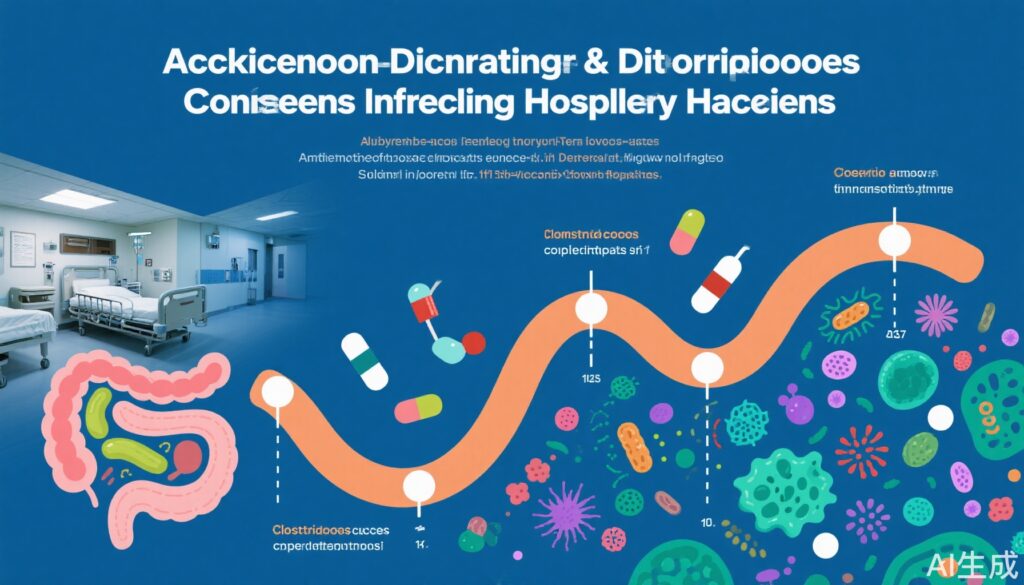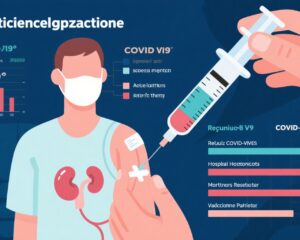Highlights
- A large cohort study from Israel confirms that antibiotic exposure approximately doubles the risk of hospital-onset CDI among noncarriers of C. difficile.
- Asymptomatic C. difficile colonization strongly predicts CDI development, with a hazard ratio exceeding 27, but additional antibiotic exposure does not significantly increase risk in carriers.
- Beta-lactam/beta-lactamase inhibitor combinations, particularly piperacillin-tazobactam, confer the highest antibiotic-associated risk of CDI among hospitalized patients.
- Preventive strategies beyond antibiotic stewardship, including probiotics and monoclonal antibodies, may be warranted for asymptomatic carriers to mitigate CDI risk.
Background
Clostridioides difficile infection (CDI) represents a significant healthcare-associated infection globally, characterized by diarrhea and colitis, with substantial morbidity, mortality, and healthcare costs. Antibiotic exposure disrupts the protective gut microbiome, facilitating C. difficile overgrowth and toxin production. Broad-spectrum antibiotics are well-established risk factors for CDI. However, the interplay between asymptomatic carriage of C. difficile and antibiotic exposure in determining CDI risk remains incompletely understood. The referenced Israeli study, alongside accumulated systematic reviews and meta-analyses, advances understanding of CDI risk stratification in hospital settings.
Key Content
Prospective Cohort Study in Israel (Gilboa et al., 2025)
From June 2017 to June 2023, Gilboa and colleagues prospectively analyzed 33,756 hospitalizations involving 23,001 patients at a tertiary medical center routinely screening patients for C. difficile carriage. The cohort median age was 78 years, with 52.8% male.
– CDI incidence was substantially higher among those positive for asymptomatic carriage (4.1%) compared to noncarriers (0.1%).
– A positive C. difficile screen at admission was associated with a markedly elevated risk of CDI (HR 27.5; 95% CI, 18.7–40.3).
– Antibiotic exposure doubled the risk of CDI across the cohort (HR 1.98; 95% CI, 1.24–3.16), with an 8% increased risk per additional day of antibiotic treatment (HR 1.08 per day).
– Piperacillin-tazobactam exhibited the highest risk among antibiotic classes (HR 2.18; 95% CI, 1.41–3.36).
– Notably, antibiotic exposure in asymptomatic carriers did not significantly further increase CDI risk (HR 1.07; 95% CI, 0.73–1.58).
This indicates that antibiotic stewardship may be especially effective in noncarriers to reduce CDI risk, while asymptomatic carriers might require complementary interventions.
Systematic Reviews and Meta-Analyses on Antibiotic Use and CDI Risk
Several meta-analyses reinforce the central role of antibiotic exposure in CDI pathogenesis:
– A 2013 meta-analysis demonstrated variability in CDI risk by antibiotic class, with clindamycin (OR ~16.8), fluoroquinolones (OR ~5.5), and cephalosporins/monobactams/carbapenems (OR ~5.7) posing highest risks, while tetracyclines had no effect.1
– Proton pump inhibitor (PPI) use, often co-administered with antibiotics, independently increases CDI risk (OR ~1.8), highlighting the multifactorial nature of CDI susceptibility.2
– A meta-analysis of pediatric inpatients found prior antibiotic exposure increased CDI risk (OR ~2.14), although adjusted models showed non-significant associations, underscoring complexities in risk assessment.3
– Probiotic prophylaxis meta-analyses suggest moderate-quality evidence supporting their role in reducing CDI risk, particularly in patients receiving multiple antibiotics or in high-risk hospital settings.4
Implications for Infection Control and Prevention in Hospitalized Patients
The Israeli study and extant literature collectively underscore:
– The necessity of rigorous antibiotic stewardship to minimize unnecessary broad-spectrum antibiotic use, thereby protecting microbiota and reducing CDI incidence.
– The importance of targeted screening upon admission for asymptomatic C. difficile carriage to stratify patients’ risk.
– Potential adjunctive prophylactic interventions for carriers, such as probiotics, monoclonal antibodies (e.g., bezlotoxumab), or emerging biotherapies, pending further research on efficacy and microbiome impact.
Expert Commentary
This robust multicenter study validates and quantifies the well-recognized antibiotic-CDI risk in the context of asymptomatic colonization status. The pronounced hazard ratio for carriers suggests that colonization itself is a dominant risk determinant, overshadowing the incremental risk from additional antibiotics in this group. Mechanistically, colonization reflects an established reservoir of spores and bacterial load, facilitating transition to symptomatic infection under host or environmental triggers.
From a clinical standpoint, this stratification invites personalized infection control strategies rather than uniform antibiotic restriction. Antibiotic stewardship remains critical for all patients but may be insufficient alone for carriers. Prophylactic approaches merit evaluation, especially in older populations with comorbidities, who represent the majority of hospitalized patients prone to CDI.
Limitations include the observational design, limiting causality inference, and possible confounding by indication. Further randomized controlled trials to assess preventive modalities in carriers are required.
Conclusion
Extensive evidence, culminating in the 2025 Israeli cohort study, confirms antibiotic exposure as a pivotal risk factor for hospital-onset CDI, particularly in patients without prior C. difficile colonization. High-risk antibiotic classes like beta-lactam/beta-lactamase inhibitor combinations demand cautious use. Asymptomatic carriage status robustly predicts CDI risk, warranting adjunctive prevention strategies beyond antibiotic stewardship. Future research should focus on validating such interventions to reduce CDI burden effectively.
References
- Deshpande A, Pasupuleti V, Thota P, et al. Community-associated Clostridium difficile Infection and Antibiotics: A Meta-Analysis of Antibiotics and the Risk of Community-Associated Clostridium difficile Infection. Antimicrob Agents Chemother. 2013 May;57(5):2326-32. doi:10.1128/AAC.02176-12. PMID: 23478961.
- Janarthanan S, Ditah I, Adler DG, Ehrinpreis MN. Assessing the Risk of Hospital-Acquired Clostridium difficile Infection With Proton Pump Inhibitor Use: A Meta-Analysis. Infect Control Hosp Epidemiol. 2016 Dec;37(12):1408-1417. doi:10.1017/ice.2016.194. PMID: 27677811.
- Wang Z, Lau BT, Shackleton T, et al. Risk Factors for Clostridium difficile Infection in Pediatric Inpatients: A Meta-Analysis and Systematic Review. Infect Control Hosp Epidemiol. 2019 Apr;40(4):420-426. doi:10.1017/ice.2019.23. PMID: 30841948.
- Goldenberg JZ, Yap C, Lytvyn L, et al. Probiotics for the prevention of Clostridium difficile-associated diarrhea in adults and children. Cochrane Database Syst Rev. 2017 Dec 11;12(12):CD006095. doi:10.1002/14651858.CD006095.pub4. PMID: 29227384.
- Gilboa M, Regev-Yochay G, Meltzer E, et al. Antibiotic Use and the Risk of Hospital-Onset Clostridioides Difficile Infection. JAMA Netw Open. 2025 Aug 1;8(8):e2525252. doi: 10.1001/jamanetworkopen.2025.25252. PMID: 40779269; PMCID: PMC12334957.


